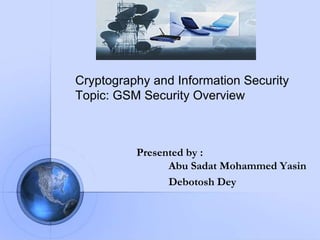
Presentation one-gsm
- 1. Presented by : Abu Sadat Mohammed Yasin Debotosh Dey Cryptography and Information Security Topic: GSM Security Overview
- 2. Content Introduction Architecture Security Concern Security Features Security model Security Algorithms A3, The MS Authentication Algorithm A8, The Voice-Privacy Key Generation Algorithm A5/1 Stream Cipher A5/1 (Key Generation) Conclusion
- 3. GSM: Introduction GSM - Group Special Mobile or General System for Mobile Communications. GSM is the Pan-European standard for digital cellular communications. GSM was established in 1982 within the European Conference of Post and Telecommunication Administrations (CEPT). In 1991 the first GSM based networks commenced operations.
- 5. GSM: Architecture A GSM network is made up of three subsystems: The Mobile Station (MS) Mobile Equipment (ME) Physical mobile device Identifiers IMEI – International Mobile Equipment Identity Subscriber Identity Module (SIM) Smart Card containing keys, identifiers and algorithms Identifiers Ki – Subscriber Authentication Key IMSI – International Mobile Subscriber Identity TMSI – Temporary Mobile Subscriber Identity MSISDN – Mobile Station International Service Digital Network PIN – Personal Identity Number protecting a SIM LAI – location area identity
- 6. GSM: Architecture The Base Station Sub-system (BSS) Comprising a Base Station Controller (BSC) and Several Base Transceiver Stations (BTS)s The Network and Switching Sub-system (NSS) comprising an Mobile services Switching Center (MSC) and associated registers Home Location Register (HLR), Authentication Center (AuC), Visitor Location Register (VLR) The interfaces defined between each of these sub systems include: 'A' interface between NSS and BSS 'Abis' interface between BSC and BTS (within the BSS) 'Um' air interface between the BSS and the MS
- 7. GSM: Security Concerns Operators Bills right people Avoid fraud Protect Services Customers Privacy Anonymity
- 8. GSM: Security Features Key management is independent of equipment Subscribers can change handsets without compromising security Subscriber identity protection not easy to identify the user of the system intercepting a user data Detection of compromised equipment Detection mechanism whether a mobile device was compromised or not Subscriber authentication The operator knows for billing purposes who is using the system Signaling and user data protection Signaling and data channels are protected over the radio path
- 9. GSM: Security Features The security mechanisms of GSM are implemented in three different system elements: The Subscriber Identity Module (SIM) - The SIM contains the International Mobile Subscriber Identity IMSI, the individual subscriber authentication key (Ki), the ciphering key generating algorithm (A8), the authentication algorithm (A3), as well as a Personal Identification Number(PIN). The GSM handset - The GSM handset contains the ciphering algorithm (A5). The GSM network - The encryption algorithms (A3, A5, A8) are present in the GSM network
- 10. GSM: Security Model Mobile station authentication
- 11. GSM: Security Algorithms. A3, The MS Authentication Algorithm A8, The Voice-Privacy Key Generation Algorithm A5/1, The Strong Over-the-Air Voice-Privacy Algorithm
- 12. GSM: A3, The MS Authentication Algorithm Inputs are the RAND from the MSC the secret key Ki from the SIM generates a 32-bit output, which is the SRES response. A3 RAND (128 bit) Ki (128 bit) SRES (32 bit)
- 13. GSM: A8, The Voice-Privacy Key Generation Algorithm Inputs are the RAND from the MSC the secret key Ki from the SIM generates a 64-bit output, which is Session Key Kc. A8 RAND (128 bit) Ki (128 bit) KC (64 bit)
- 14. GSM: A5/1 Stream Cipher Combination of 3 linear feedback shift registers (LFSRs) Each register has an associated clocking bit. The registers are clocked in a stop/go fashion using a majority rule.
- 15. GSM: A5/1 Stream Cipher At each cycle, the clocking bit of all three registers is examined and the majority bit is determined. A register is clocked if the clocking bit agrees with the majority bit. At each step at least two or three registers are clocked.
- 16. GSM: A5/1 Stream Cipher(Example) Majority of clock bit (1,0,1) = 1 First and third LFSRs will be clocked but not the second. 1 1 0 0 1 1 0 0 1 1 0 0 1 1 0 0 1 1 0 0 0 1 1 1 1 0 0 0 0 1 1 1 1 0 0 0 0 1 1 1 1 0 0 0 1 1 0 1 0 1 0 1 0 1 0 1 0 1 0 1 0 1 0 1
- 17. GSM: A5/1 Stream Cipher(Example) 1 1 0 0 1 1 0 0 1 1 0 0 1 1 0 0 1 1 0 0 0 1 0 1 1 1 0 0 0 0 1 1 1 1 0 0 0 0 1 1 1 1 0 0 0 0 1 0 1 0 1 0 1 0 1 0 1 0 1 0 1 0 1 0 Keystream bit will be 0 1 0 = 1
- 18. GSM: A5/1 Stream Cipher (Initialization) 64-bit Session Key loaded in to the LFSR(bit by bit) The majority clocking rule is disabled 22-bit frame number is also loaded into the register The majority clocking rule applies from now on. The registers are clocked one hundred times. Generated keystream bits are discarder. In order to mix the frame number and keying material together.
- 19. GSM: A5/1 (Key Generation) 228 bits of keystream output are generated. The first 114 bits are used to encrypt the frame from MS(Mobile Station) to BTS(base transceiver station). The next 114 bits are used to encrypt the frame from BTS to MS. The same Session Key is used throughout the call, but the 22-bit frame number changes during the call, that is why, A5 algorithm is initialized again with the same session key and the number of the next frame.
- 20. Conclusion GSM is the most widely used cellular network standard. Security mechanism specified in the GSM make it a secure cellular telecommunication available. The use of authentication, encryptions ensures the privacy and anonymity of the system’s users.
